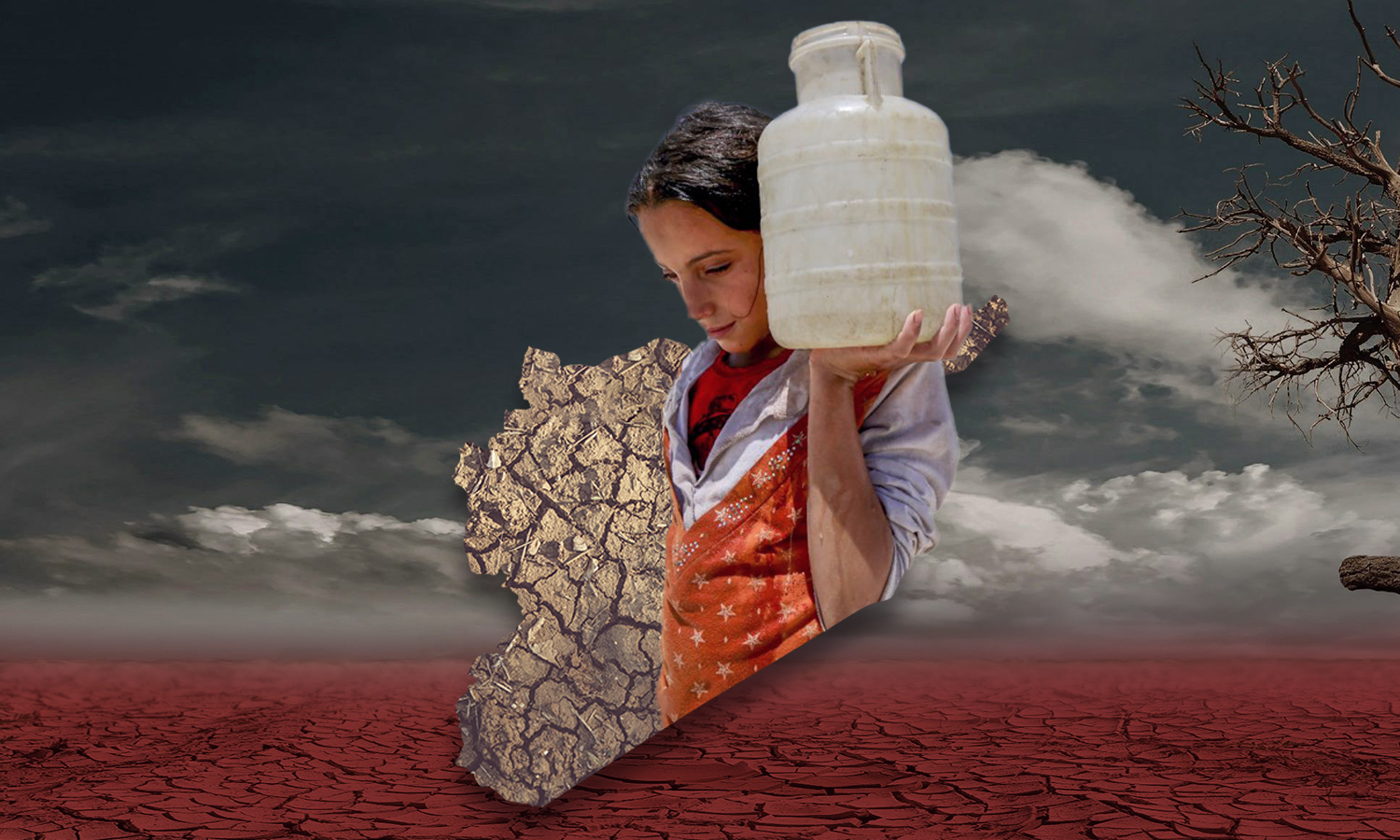



Hassan Ibrahim | Jana al-Issa
The water shortage crisis in Syria is intensifying day after day; the water level is falling to unprecedented levels, major water sources have dried up, and others are on their way to drying up. Such horror is fed by the warring parties who have contributed to the destruction of the infrastructure that provided water services.
Since the eruption of the Syrian revolution in 2011, the water issue has begun to emerge as one of the most important challenges for the civilian population after parties to the conflict used it as a tool to achieve political, military, and economic gains.
The Global Conflict Risk Index (GCRI) for 2022 considered Syria to be the country most vulnerable to drought in the Mediterranean region, and the United Nations warned that drought waves in this region will increase in length and intensity, and obtaining safe drinking water has become a challenge for millions of Syrians.
Syria is one of 25 countries (housing One-quarter of the population) facing extremely high water stress, which means that it uses more than 80% of its renewable water supply for irrigation, livestock, industry, and household needs, and even short-term drought exposes these places to risk of running out of water.
In this weekly file, Enab Baladi sheds light on the drought of water resources in various conflict areas in Syria and the decline in the level of their main water sources.
Local officials, experts, and research fellows, met by Enab Baladi, reviewed the environmental, economic, and political impacts and repercussions.
In the regime-held areas, a number of springs and lakes in the southern region began to gradually recede in the summer of 2017. Lake Muzayrib dried up completely in 2020, and Lake Zayzoun and Tal Shihab waterfalls also dried up seasonally in the summer.
Every summer, the dams in Quneitra governorate, which are among the most important sources of water for irrigating agricultural areas, suffer a significant decrease in their water reserves as a result of low rainfall and excess consumption, and a number of them are damaged.
The state of water scarcity in neighborhoods of Damascus and its countryside has become almost commonplace, forcing most residents to rely almost entirely on tanker water for domestic use or drinking amid the frequent price hikes that these tankers face; in addition, it is not guaranteed to be clean.
An investigation by the Syria Indicator project about the coastal Latakia government, published in December 2021, revealed the role of infringements on water lines (theft) in the phenomenon of Latakia thirst. It also revealed the involvement of influential figures from the regime’s army and intelligence officers in stealing water to irrigate their farms and fill their villas’ swimming pools.
In the eastern countryside of Hama city, only 29 projects are operating in the Saboura water unit in the Salamiya area, out of 88 suspended projects in the region due to drought or destruction as a result of military operations amid the inability of water institutions to provide alternatives.
The situation is not much different in the rest of the governorates, as the main sources of water have also dried up, while some of them have been vandalized by the war or inoperable as a result of the absence of fuel and electricity, which leads to the same result for the population of almost complete absence of water, and the population is forced to rely on polluted water.
Water Stress: The ratio of water demand to renewable supplies, and competition for local water resources.
The narrower the gap between supply and demand, the more vulnerable a place becomes to water shortages. A country facing severe water stress means it is using at least 80% of its available supplies, while high water stress means it is withdrawing 40% of its supplies.
Syria has suffered three droughts since 1980, the most severe of which was between 2006 and 2010, according to a study issued by the Dutch Pax for Peace organization.
In the summer of 2021, Syria witnessed record-low levels of rainfall and a sharp decline in the flow of water to the Euphrates River. It affected livestock breeding, as there was no growth in vegetation in the spring and summer of 2021.
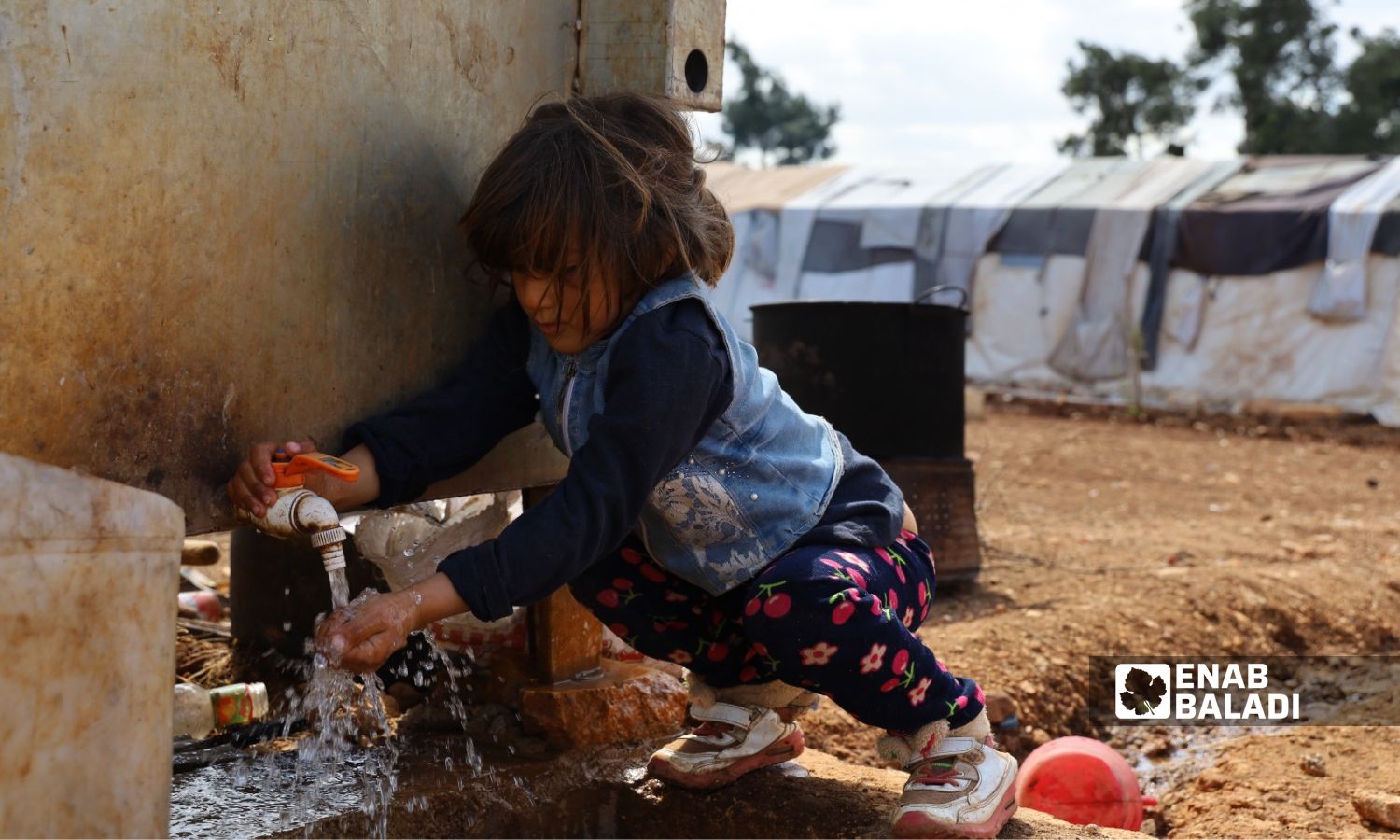
A child girl in one of the camps in the Ziyadiyah area in the center of Afrin city in the northern countryside of Aleppo – January 2022 (Enab Baladi/Amir Kharboutli)
Traditional water resources in Syria include surface water resources, which consist of a group of waterways like internal and external rivers and groundwater resources, in addition to non-traditional water resources, which include wastewater, agricultural and industrial water, and desalination water.
Water resources in Syria are described as few and limited, and Syria has been classified as part of a group of water-poor countries since 2000, as natural, geographic, and political factors determine the size of these resources.
According to a study released in August 2016 by Mohammad al-Abdullah, research fellow at the Omran Center for Strategic Studies, the number of main water basins stored in Syrian territory is seven: the Euphrates and Aleppo basins, the Tigris and Khabur basins, the coastal basin, the Badia basin, the Orontes (Asi) basin, the Barada and al-Awaj basin, and the Yarmouk basin.
There are a number of large and medium dams within these basins, the most prominent of which are the Euphrates, Tishreen, Baath, al-Wahda, Rastan, Qatinah, Taldo, and Mahardah dams.
At least 16 rivers and their tributaries flow in Syria, five of which are internationally shared (Euphrates, Tigris, Orontes, Yarmouk and the Southern Great River), and their flow represents about 75% of the total regulated surface water resources in the country, and more than 45% of the water resources available for use, according to an April-2019 report by Fanack Water website, which specializes in studying the water situation in the Middle East.
There are nine main lakes in Syria: Lake Al-Assad, Jaboul, Tishreen, Qatina, Otaiba, Khatuniya, Muzayrib, al-Baath, and Masadah.
The water level has decreased in bodies of water, springs, rivers, and wells in the areas of northwestern Syria, both those controlled by the Syrian Salvation Government (SSG) in Idlib and the western countryside of Aleppo and the areas controlled by the Syrian Interim Government (SIG) in the northern and eastern countryside of Aleppo and the cities of Tal Abyad and Ras al-Ain.
Following the earthquake on February 6, 2.1 million people in northwestern Syria need urgent assistance in the field of water, sanitation, and personal hygiene, according to the latest United Nations reports on the region, which includes 4.5 million people, 4.1 million of whom are in need of assistance, and 3.3 million of whom are suffering of food insecurity.
Saleh al-Duraie, director of water resources in the Salvation Government, told Enab Baladi that the water level in the Idlib region decreased compared to last year, and he gave an example of a decrease in the water level in the town of al-Dana, north of Idlib, by 13 meters, and in the town of Zardana, the level decreased by five meters. In the al-Rouj Plain, it decreased by three meters compared to last year.
Al-Duraie added that there are ten irrigation stations and projects in the Salvation-held areas, all of which serve agricultural lands, and the irrigated area of the station or project varies from one to another. For example, the northern and southern al-Talul irrigation station on the Asi River in the Salqin countryside irrigates 200 hectares, while the Hayr Jamous station irrigates 55 hectares, the al-Duwaisat catchment dam irrigation project irrigates 100 hectares, the Qastoun dam irrigation project irrigates 200 hectares, while irrigation wells in the al-Rouj Plain irrigate 260 hectares.
The crisis of thirst and water scarcity has been continuing in the city of al-Bab in the eastern countryside of Aleppo for seven years, and its severity is escalating over time. It began after the Syrian regime took control of the Ain al-Baidha and Khafsa water pumping sites and stations in the eastern countryside of Aleppo in late 2016, and cut off water from the city.
The suffering of more than 300,000 residents of al-Bab city in securing drinking water is exacerbated, and there are more than 4,500 hectares of agricultural land on the way to drought and desertification as a result of water scarcity.
The water situation in the city is irregular; five wells have gone out of service, and only eight wells remain operational in al-Bab, with a flow rate of 40 cubic meters per hour, according to a statement by the local council in the city of al-Bab.
In Jindires region, north of Aleppo, a spring near the shrine of Abdul-Rahman dried up this year, and the level of the Afrin River dropped to approximately 90% (the Afrin River is one of the most important sources that supplies agricultural lands with water, and it originates from the Taurus Mountains). The river’s bed began to suffer from severe drought, according to a statement obtained by Enab Baladi from the local council in Jindires.
The council explained that the water level decreased in a number of wells for water stations, and in some of them the matter was limited to turbidity in the water of the wells.
The number of operating water stations in Jindires is 11, and the water level in them decreased by 20% and about 25% of the wells dried up. Household water levels in private wells decreased by 25%.
The director of the Water Corporation in Afrin, Abdul-Qader al-Hafiz, told Enab Baladi that the water level in the Maydanki Dam lake has decreased significantly, without estimates of the percentage of decline, pointing out that the Maydanki Dam station and the “filtration” station in the village of Sharan are the most prominent water stations in the region feeding Afrin, Azaz, and the village of Qibar.
The water level of the Khabur River decreased and became almost dry, leaving its negative effects on the Jazeera region in northeastern Syria after it was an important water resource for the region.
Al-Khabur originates near the Turkish-Syrian border. It enters Syria from the Ras al-Ain area and extends until al-Busayrah in Deir Ezzor. It is about 320 kilometers long.
The director of the Water Corporation in the local council in Ras al-Ain, northwest of al-Hasakah, where the Interim Government is in control, Bashir Mulla Matar, told Enab Baladi that the drop in the water level of the Khabur River, which has become almost dry, has led to the interruption of water to more than 40 villages and towns and affected agricultural lands of 2,000 hectares.
He stated that the al-Manajir station is a water treatment station that was drawn from the Khabur River, but the dryness of the river stopped it from working, and the people began to depend on mobile water tanks, pointing out that the water level decreased between 5 and 10 meters in Ras al-Ain wells, during the current year only.
The Syrian Jazeera region, where the Autonomous Administration of North and East Syria (AANES), has suffered successive droughts over the past years, especially since late 2020, and the level of water flowing from Turkey to the Syrian part of the Euphrates River has decreased by 65%, according to a report by the United Nations Office for the Coordination of Humanitarian Affairs (OCHA) in 2020.
More than 5 million people in Syria depend directly on the river as a source of water, and 54 out of 73 water stations along the western bank of the Euphrates River were greatly affected due to the dangerous drop in water levels, according to a report by OCHA in June 2021.
According to a study prepared by the ORSAM Center for Middle Eastern Studies, the Euphrates River dropped to its lowest level ever in May 2021, causing the worst drought since 1953.
The significant decrease in water reserves in the Tabqa, Tishreen, and Baath dams on the Euphrates River threatens agricultural production in more than 200,000 hectares of irrigated land.
Last July, the Water Directorate in al-Hasakah announced that the al-Hasakah city, Tal Tamr and their villages, and the Washokani and Ras Al-Ain camps were “disaster” areas in which life was almost non-existent due to a stifling water crisis, which had occurred over the past years.
The directorate attributed the reason to the interruption of drinking water from the Alouk station located in the city of Ras al-Ain, which is under the control of the Syrian National Army factions, accusing Russia, the regime, and Turkey of being behind this.
The Jaqjaq River, which is the lifeline in Qamishli, has turned into a garbage dump, a sewage stream for the waste of factories and workshops in the Turkish city of Nusaybin and factories in al-Hasakah. The river originates in Turkey and runs through Syrian territory in the cities of Qamishli and al-Qahtaniyah. It is considered one of the main tributaries of the Khabur River.
On September 25, the Mahkan water station in the eastern countryside of Deir Ezzor went out of service due to it being damaged as a result of clashes between the Syrian Democratic Forces (SDF) and tribal fighters, and 17,000 people were deprived of access to water, according to a statement issued by OCHA.
The phenomenon of soil salinity has spread in the lands of the eastern countryside of Deir Ezzor governorate. Farmers attributed its causes to the slowness in cleaning and rehabilitating excess water drains, as its accumulation over long periods of time causes soil salinity.
According to statistics conducted by the Irrigation Committee of the Autonomous Administration in the region, between 2,300 and 2,500 hectares were exposed to salinization, and their soil became unsuitable for agriculture.
One of the workers at the irrigation station in the village of al-Shahil in the Deir Ezzor countryside (whose name was withheld because he was not authorized to make a statement) told Enab Baladi that salinization resulted from the vertical wells being out of service since 2013, adding that out of 85 wells in the area, there are only ten wells currently working after local initiatives led to their operation.
A large portion of these wells were vandalized, as boot stations, electricity cables, and covered drainage networks responsible for drawing excess water from the soil and discharging it into the Euphrates River were looted.
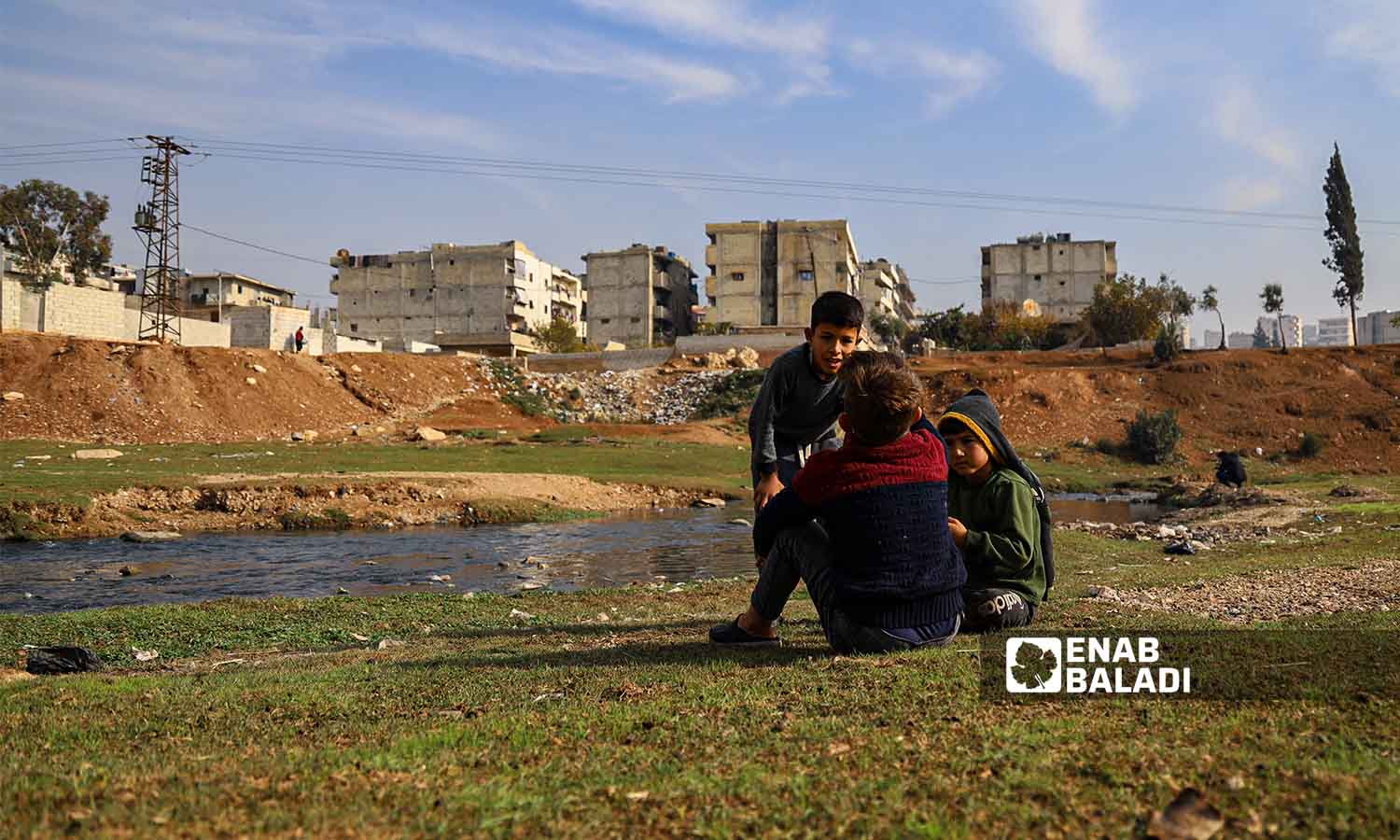
A group of children playing near the Afrin River that is polluted with sewage and factory waste – December 12, 2022 (Enab Baladi/Amir Kharboutli)
The Director General of Water Resources in the Salvation Government, Saleh al-Duraie, explained that the Syrian regime deliberately opens the gates of the dams built on the Orontes River in the winter and during floods, which leads to a rise in the river’s water levels and the drowning of agricultural lands on its banks in northern Syria.
He stated that last year, the regime deliberately opened the sugar factory drain in Salhab, Hama, and threw the factory waste into the Orontes (Asi) River, which led to the death of fish due to chemicals and heavy elements such as mercury and other highly toxic substances.
Three days after the earthquake, the waters of the Orontes River flooded lands, houses, and tents in the village of al-Talul in the western countryside of Idlib, causing the displacement of more than 150 families on February 9.
The Ministry of Agriculture and Irrigation in the Salvation Government attributed the rise in water levels to the opening of the Rastan Dam by the Syrian regime, in addition to the collapse of the reinforced cement dam between Antakya and Reyhanli in Turkey.
While the statements of regime officials and its media coverage ignored Idlib governorate when talking about the areas affected by the earthquake (the regime mentioned Idlib, for the first time during the disaster, when it included it in its declaration of areas affected by the earthquake), the regime continued to exploit the disaster politically. The pro-regime Al-Watan local newspaper reported, according to Thaer Salhab, the governor of Idlib, that the presence of the al-Talul dam in opposition-controlled areas prevents the competent authorities from arriving and inspecting the dam.
The Syrian regime has controlled the Ain al-Baidha water pumping station in the eastern countryside of Aleppo since 2016, and it has been idle, depriving the city of al-Bab and its suburbs of drinking water, as the city has relied since 2006 on the water of the Euphrates River, which reaches the Ain al-Baidha pumping station. It is close to the Kuweires Military Airport, about 12 kilometers from al-Bab.
The regime’s practices do not stop there, as the rubble of water stations that were destroyed by aircraft and missiles of the regime and its allies is still evidence of the systematic destruction of the basics of life in areas outside its control.
Russian raids targeted the al-Arshani water pumping station, west of Idlib, in January 2022, taking it out of service, depriving about 300,000 people of water, and then it was rehabilitated weeks later.
Autonomous Administration officials, international reports, and humanitarian organizations have repeatedly accused Turkey of reducing water levels flowing from the Euphrates River to Syrian territory and that Ankara is responsible for disabling the Alouk station in the city of Ras al-Ain. The Turkish authorities meet these accusations with denials.
The Syrian regime and the Autonomous Administration also accuse Turkey of lowering the level of the Euphrates River as a result of it detaining larger quantities than usual in the dams it built on its course before it reached Syria.
The Alouk station supplies water to the city of al-Hasakah and its countryside and is considered the main source of water for about 460,000 people in the city of al-Hasakah, Tal Tamr, and the al-Hol and Arisha camps.
Human Rights Watch said that the Turkish authorities have imposed severe restrictions since February 2021 on the flow of water to the Syrian part of the Euphrates River, much less than 500 cubic meters, which was stipulated in the 1987 agreement between Turkey and Syria.
Universal principles govern the use of shared waters, including the fair and reasonable sharing of water resources, the obligation not to cause serious harm to countries that share rivers, and the general duty to notify and consult countries when planning any relevant economic activity, including the Berlin Water Resources Rules.
For its part, Turkey denies the accusations and places the blame and reasons on the Syrian regime and the SDF, which is the military wing of the Autonomous Administration. The Turkish Foreign Ministry said in a statement in 2021 that the SDF and the Assad regime are deliberately obstructing the access of electricity to the Alouk station, which makes providing water from the station impossible.
There are 14 Turkish dams on the Euphrates River, the most prominent of which is the Ataturk Dam, which is part of the Southeast Anatolia Project (GAP), which aims to generate hydraulic energy, control floods, and store water.
The Turkish Foreign Ministry considered that the news and comments about Turkey cutting off the water of the Euphrates River or reducing the amount it passes through it are unfounded.
The Foreign Ministry said that Turkey has not, in its history, reduced the amount of water it passes through cross-border rivers in order to achieve political goals or any other goal.
The ministry stated that it must not be forgotten that the water distress that is being reported in Syria and Iraq results from the waste of limited water resources in these two countries, as well as from the struggle of the conflicting parties to control these resources and use water to serve their goals.
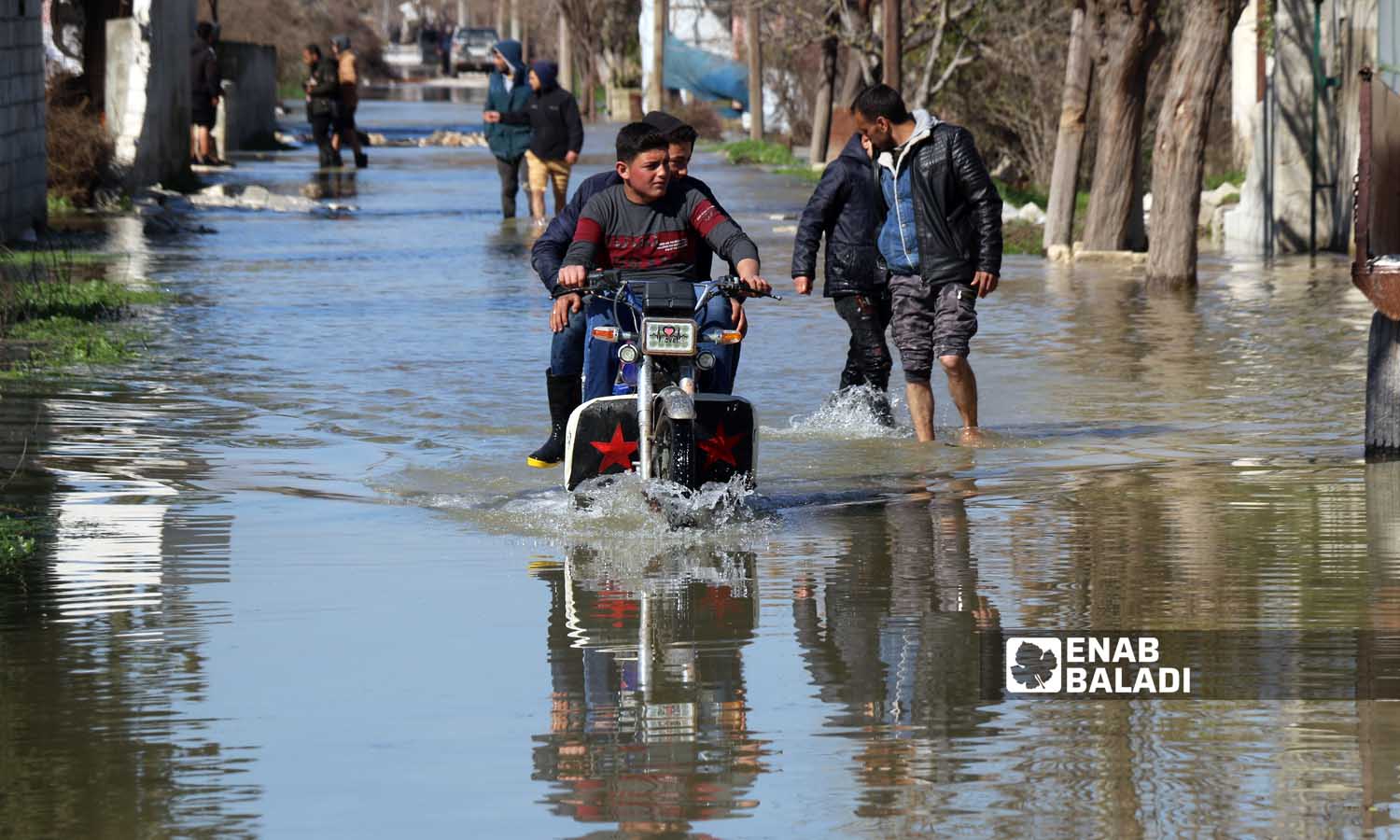
The streets of the village of al-Talul are flooded with water from the Orontes River due to its high levels – February 9, 2023 (Enab Baladi/Iyad Abdul Jawad)
Studies indicate that Syria is facing bad conditions in the water sector as a result of drought and war, and the Fanack website spoke about expectations that five water basins in Syria will be depleted, which are Barada and al-Awaj, Orontes, the Syrian Steppe, the Tigris and al-Khabur, and the Yarmouk.
Water shortages average 1,727 million cubic meters per year, and will reach 6.2 billion cubic meters in 2050, due to increasing consumption and mismanagement of non-renewable resources coupled with population and economic growth.
The decrease and fluctuation of rainfall will exacerbate this situation, as groundwater levels will decrease, some springs will dry up, and some rivers will decrease in discharge, according to the Fanack website.
Economist Abdul-Hakim al-Masri told Enab Baladi that global climate change has led to a change in rainfall rates, which is a general condition that dozens of countries suffer from.
However, in Syria, the sabotage of the water resources infrastructure, the increase in random drilling of wells, and the lack of regular maintenance, as well as the migration of expertise working on the restoration of irrigation canals and dams, led to the drying up of its most important water sources.
In terms of the agricultural sector, the area of irrigated agricultural land is one million and 35,000 hectares, and it drains the largest amount of water, which will increase pressure on groundwater and portend in a future financial catastrophe that will have major repercussions on agricultural production, according to Mohammad Manhal al-Zoubi, expert in water and natural resources at the regime’ general authority for scientific agricultural research.
Al-Masri, the Minister of Economy in the Syrian Interim Government, said that the lack of water availability would certainly lead to a decrease in the areas of agricultural land that were cultivated with irrigation and a decrease in productivity, in addition to the reluctance of a large number of farmers from farming as a result of the loss of their crops.
Al-Abdullah, economic fellow researcher at the Omran Center, considered that the water resources file is multi-faceted and has an economic, social, political, and security facet, and one cannot be separated from the other, and the importance of water is no less than any pending file in Syria, and he wondered about the existence of “early recovery” in light of the deteriorating water situation, especially in the northwestern and northeastern regions of Syria.
Al-Abdullah told Enab Baladi that water, from 2011 to the present, has been one of the strategic weapons in the hands of the ruling parties in areas of influence and control in Syria, and no party has hesitated to use this resource as a weapon to achieve private gains, whether economic, political, or military.
When analyzing the role of water in the conflict in Syria, we rely on models of weaponization, as both state and non-state actors are characterized by behaving in similar ways in their violent use of water, according to a study by Marwa Daoudy for the Chatham House entitled “Undercurrents: Water Weaponization in Syria, and Mental Health in Politics,” released in 2020.
Daoudy identified four interconnected strategies for using water as a weapon, which are based on controlling resources and infrastructure, namely dominance and legitimacy, water as a military target (when targeting stations and resources), as a military tool (such as seizing water to terrorize the population), and as a tool for cooperation (cutting off water to achieve military goals), taking into account that through the four categories, water can be both an offensive and defensive weapon.
The researcher reached three conclusions about the role of water in the conflict in Syria. First, events indicate that after the war, the possibility of using water as a weapon in the relationship between the state and society will increase. Second, it becomes important to focus on the dual offensive-defensive capabilities of water, which allows actors, both governmental and non-governmental, to cause damage beyond their capabilities.
The third conclusion was the need to take full account of the violent nature and strategic consequences of water cooperation between opposing parties to the conflict, and that when studying water policy, conflict and cooperation become two sides of the same coin.
A study by the Operations Policy and Research Center (OPC) in June 2022 supported the possibility of achieving one scenario of the drought’s impact on the nature and form of the conflict in Syria, which is an increase in the crime rate in its organized and unorganized forms, and increasing rates of joining militias and extremist groups.
The investigative study considered that drought, mismanagement of the agricultural sector and water resources, and 11 years of conflict are all factors that have created and will create more negative economic repercussions of the drought crisis in Syria.
These repercussions are manifested in several forms, most notably the emergence of a bidding war for the scarce wheat crop between the four areas of control, the difficulty of purchasing wheat from external sources due to the rise in global prices, and the scarcity of foreign exchange and the continued decline of the country’s exports, most of which were concentrated in the agricultural sector during the last decade.
The repercussions also include damage to the livestock breeding sector as a result of the scarcity of fodder and pastures, the decline in local demand, and finally, the decline in agricultural labor market activity as one of the most prominent labor sectors in the country.
The parties to the conflict in Syria have not yet realized the seriousness of the current water situation and the seriousness of its future consequences. Water will turn into a future crisis that may result in the outbreak of a new or renewed conflict followed by new displacement movements in several areas.
Mohammad al-Abdullah – A research fellow in economic affairs
Research Fellow at Omran Center, Mohammad al-Abdullah, proposed some solutions, represented by the need to unite the efforts of all actors, whether local and international organizations concerned with the Syrian issue and government structures, and to place water as a future strategic priority, both in terms of financial and technical support and not to provide patchwork solutions.
Local authorities must be aware of the seriousness of the current and future situation and work to establish a body of a strategic nature concerned with the water resource and seek the assistance of experts at the international level and local experts to assess the reality, develop strategic solutions, and request the necessary international support and funding for it, according to the research fellow.
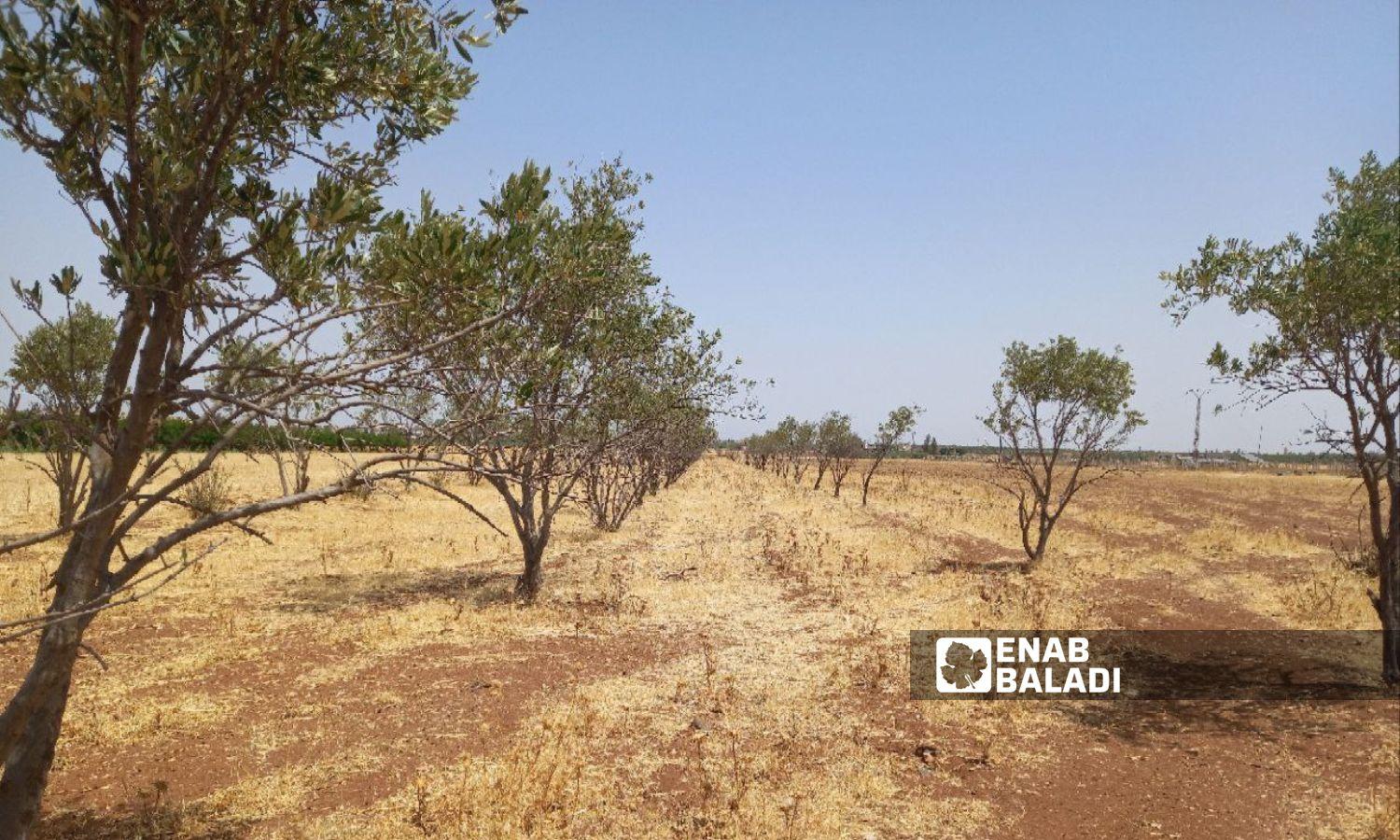
The decline of green spaces in the western countryside of Daraa – June 17, 2023 (Enab Baladi /Halim Mohammad)
if you think the article contain wrong information or you have additional details Send Correction